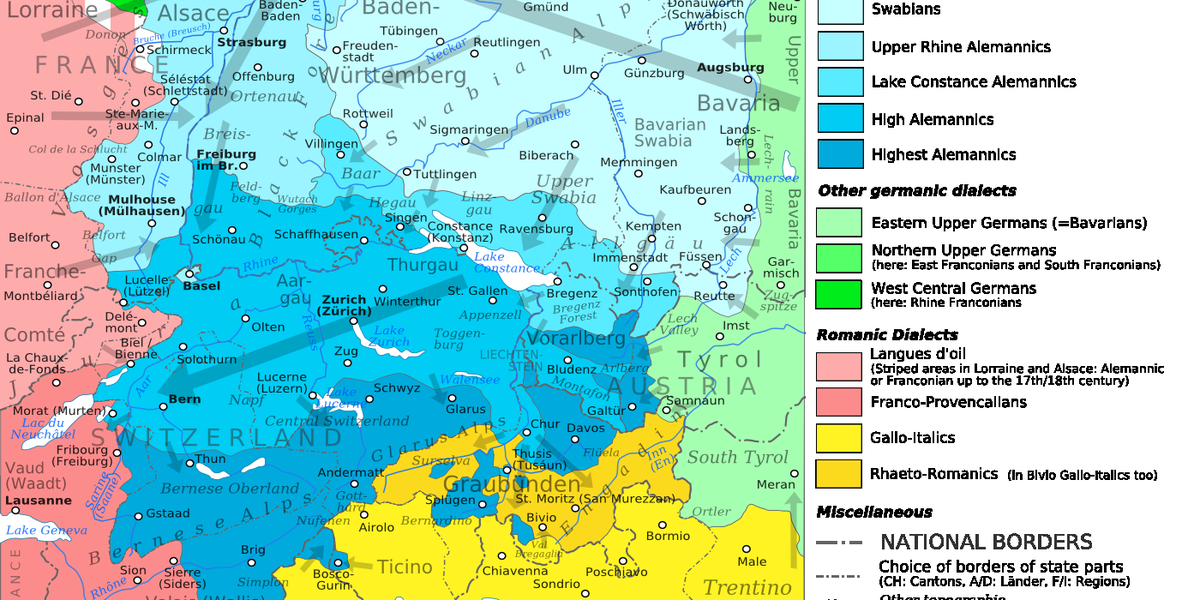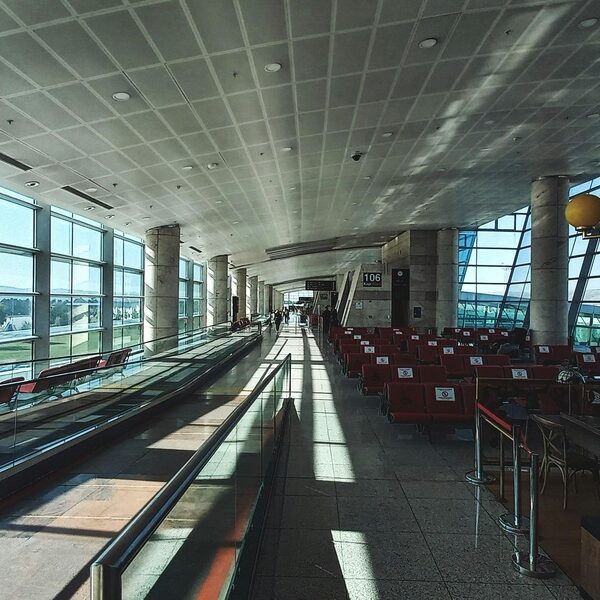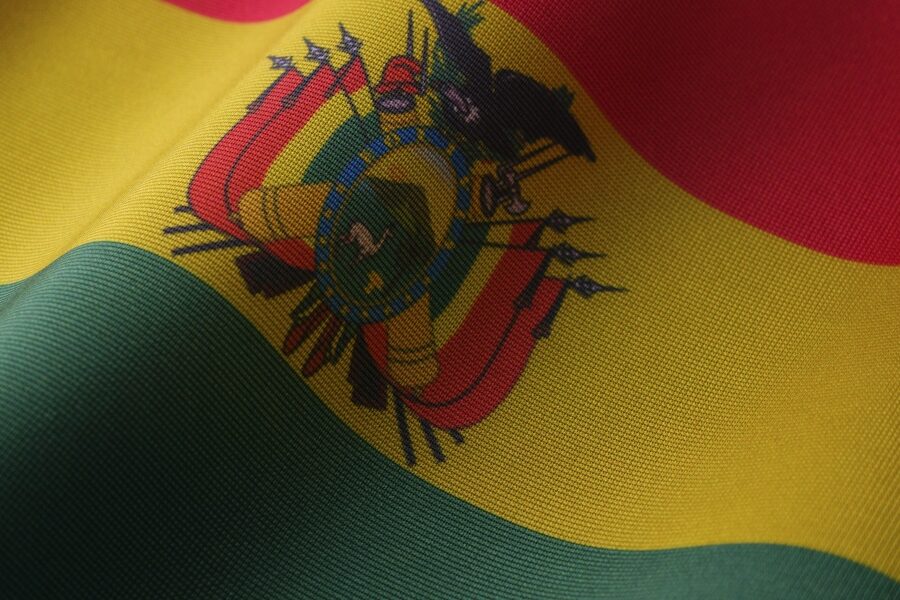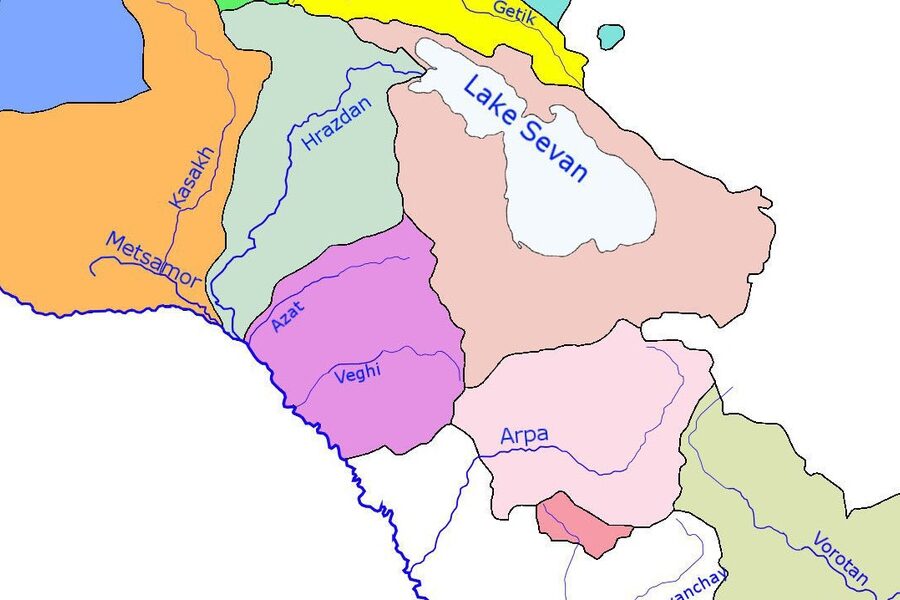Germany’s language map is a patchwork of local speech — town-by-town and valley-by-valley varieties that carry history, identity and everyday color. These dialects show up in accents, vocabulary and grammar, and they often signal where someone grew up more clearly than any map.
There are 57 Dialects in Germany, ranging from (Historical cross-border forms excluded when not substantially within modern Germany) to Westphalian. The list is compact and standardized so you can compare entries easily: Data are organized with Region,Family,Speakers (est.), and you’ll find below the names and a short snapshot of each dialect.
How different are these dialects from Standard German?
Differences range from light pronunciation shifts to distinct grammar and vocabulary; some dialects are mutually intelligible with Standard German while others require local familiarity or experience to follow. Many speakers switch between dialect and Standard German depending on context, so exposure, age and region all affect how easily someone understood.
Where can I still hear these dialects today?
You’ll hear dialects most often in rural areas, older generations, local markets and community events, but cities retain pockets too; regional radio, dialect theatre, and online recordings are good ways to sample varieties if you can’t visit in person.
Dialects in Germany
| Name | Region | Family | Speakers (est.) |
|---|---|---|---|
| Plattdeutsch (Low German) | Lower Saxony, Schleswig-Holstein, Mecklenburg-Western Pomerania, Bremen, Hamburg | Low German | 4,000,000 |
| Northern Low Saxon | Schleswig-Holstein, Hamburg, northwestern Lower Saxony | Low German (Low Saxon) | 1,800,000 |
| Westphalian | North Rhine-Westphalia (Westphalia) | Low German (Westphalian) | 1,300,000 |
| Eastphalian | Southeastern Lower Saxony, northern Saxony-Anhalt | Low German (Eastphalian) | 500,000 |
| Mecklenburgisch-Vorpommersch | Mecklenburg-Western Pomerania | Low German (East Low German) | 200,000 |
| Brandenburgisch | Brandenburg, surrounding Berlin areas | Low German / Central German transitional | 800,000 |
| Berlinerisch | Berlin | Central German (Brandenburgisch regiolect) | 1,000,000 |
| Sächsisch (Upper Saxon) | Saxony (Dresden, Leipzig) | Central German (Upper Saxon) | 4,000,000 |
| Thüringisch (Thuringian) | Thuringia | Central German (Thuringian) | 2,000,000 |
| Hessisch (Hessian) | Hesse (Frankfurt, Kassel, Wiesbaden) | Central German (Hessian) | 3,500,000 |
| Ripuarian | Cologne area, Rhineland | Central Franconian (Ripuarian) | 2,000,000 |
| Kölsch | Cologne | Ripuarian (Central Franconian) | 700,000 |
| Moselfränkisch (Moselle Franconian) | Moselle region, western Rhineland-Palatinate, Saarland | Central Franconian (Moselle Franconian) | 1,500,000 |
| Pfälzisch (Palatine German) | Palatinate (Rhineland-Palatinate) | West Central German (Palatine) | 1,200,000 |
| Saarländisch | Saarland | Moselle Franconian (Central German) | 400,000 |
| Rheinfränkisch (Rhenish Franconian) | Rhineland-Palatinate, parts of Hesse | West Central German (Rhenish Franconian) | 2,000,000 |
| Rhenish (Rheinisch) | Rhineland (NRW), Cologne, Bonn, Koblenz | West Central German (Rhenish umbrella) | 3,000,000 |
| Mainfränkisch (Main Franconian) | Northern Bavaria (Würzburg), parts of Bavaria | East Franconian (Franconian) | 600,000 |
| Oberfränkisch (Upper Franconian) | Upper Franconia (Bavaria) | East Franconian (Franconian) | 700,000 |
| Unterfränkisch (Lower Franconian in Bavaria) | Lower Franconia (Würzburg area) | East Franconian (Franconian) | 400,000 |
| Fränkisch (East Franconian) | Northern Bavaria, parts of Baden-Württemberg | East Franconian (Franconian) | 2,500,000 |
| Bairisch (Bavarian) | Bavaria (southern), parts of Austria | Upper German (Bavarian) | 9,000,000 |
| Nordbairisch (Northern Bavarian) | Upper Palatinate, northern Bavaria | Bavarian (Northern) | 1,500,000 |
| Mittelbairisch (Central Bavarian) | Munich region, Upper Bavaria, Lower Bavaria | Bavarian (Central) | 5,000,000 |
| Südbairisch (Southern Bavarian) | Alpine Bavaria, Berchtesgadener Land | Bavarian (Southern) | 1,000,000 |
| Schwäbisch (Swabian) | Stuttgart area, Baden-Württemberg, Bavarian Swabia | Alemannic (Swabian) | 5,000,000 |
| Badisch (Baden dialect) | Baden (southwestern Baden-Württemberg) | Alemannic (Low Alemannic) | 2,500,000 |
| Alemannisch (Alemannic, umbrella) | Southwestern Baden-Württemberg (Breisgau), parts of Bavaria | Alemannic | 3,000,000 |
| Schwyz? (not in Germany) excluded | — | — | 0 |
| (NOTE: placeholder row removed) | — | — | — |
| Niederrheinisch (Low Rhenish) | Lower Rhine (NRW) around Duisburg and Kleve | Low Franconian (Low Rhenish) | 1,000,000 |
| Hamburgisch | Hamburg | Northern Low Saxon / urban | 500,000 |
| Bremisch (Bremen dialect) | Bremen | Northern Low Saxon / urban | 200,000 |
| Kölsches (Cologne) — see Kölsch | Cologne | Ripuarian | 700,000 |
| Palatine Yiddish? (excluded) | — | — | 0 |
| (Preserved to ensure no non-German languages are listed) | — | — | — |
| Saarpfälzisch (Saar-Palatinate) | Saarland, Palatinate border areas | Moselle Franconian / Palatine blend | 300,000 |
| Lothringisch (within Germany only minimal, mostly in France excluded) | — | — | 0 |
| (Historical cross-border forms excluded when not substantially within modern Germany) | — | — | — |
| Upper Saxon (see Sächsisch) | Saxony | Central German (Upper Saxon) | 4,000,000 |
| Thuringian-Upper Saxon | Thuringia, Saxony | Central German transitional | 2,500,000 |
| Hohenloherisch (widely cited regional Franconian dialect) | Hohenlohe (northern Baden-Württemberg) | East Franconian (Franconian) | 150,000 |
| Markbrandenburgisch (Brandenburg) | Mark Brandenburg region | Brandenburgisch / Low German transitional | 400,000 |
| Aachener Platt | Aachen region (NRW) | Ripuarian / Low Franconian blend | 100,000 |
| Ostfriesisch (East Frisian Low German) | East Frisia (Lower Saxony) | Low German (East Frisian Low German variant) | 120,000 |
| Palatine (see Pfälzisch) | Palatinate | West Central German (Palatine) | 1,200,000 |
| Lippisch (Lippe region) | Lippe (North Rhine-Westphalia) | Westphalian / Low German | 200,000 |
| Mönchengladbach dialect (widely cited) | Mönchengladbach region (NRW) | Ripuarian / Low Franconian | 80,000 |
| Ruhrdeutsch (Ruhr area regiolect) | Ruhrgebiet (North Rhine-Westphalia) | Regiolect with Westphalian and immigrant influences | 3,500,000 |
| Sächsisch-Thüringisch (dialect continuum) | Saxony, Thuringia border region | Central German continuum | 1,800,000 |
| Bavarian Swabian (Bayerisch-Schwäbisch) | Bavarian Swabia (Bavaria) | Alemannic/Swabian blend | 500,000 |
| Franconian umbrella (Fränkisch) | Franconia (northern Bavaria, parts of Hesse) | Franconian (various) | 3,500,000 |
| Hunsrückisch (Rhineland-Palatinate) | Hunsrück region (Rhineland-Palatinate) | Rhenish Franconian / Moselle Franconian | 120,000 |
| Eifeler (Eifel region) | Eifel (Rhineland-Palatinate, NRW) | Ripuarian / Rhenish mix | 200,000 |
| Unterelbe dialects (Elbe region) | Lower Saxony/Saxony-Anhalt along Elbe | Low German / Eastphalian variants | 300,000 |
| Kurpfälzisch (Electoral Palatinate region) | Heidelberg, Mannheim area (Baden-Württemberg) | Palatine / Rhine Franconian | 450,000 |
| Lüneburg dialect (Lüneburg Heath) | Lüneburg area (Lower Saxony) | Northern Low Saxon | 80,000 |
Images and Descriptions
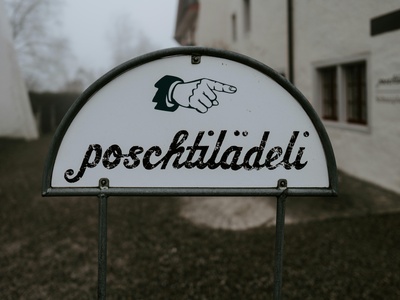
Plattdeutsch (Low German)
Historic northern German variety with distinctive vowel shifts and preserved older consonants; partly mutually intelligible with Standard German but often hard for southerners to follow; widely used in rural speech and regional media.
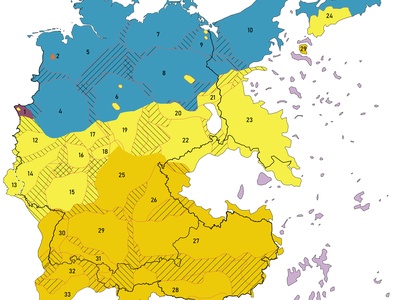
Northern Low Saxon
A northern Low Saxon group with coastal vocabulary and consonant features differing from Standard German; intelligible to other Low German speakers but challenging for Standard-only speakers.
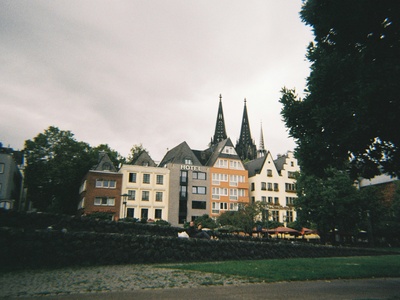
Westphalian
Westphalian shows characteristic vowel changes and consonant retention; common in rural and small-town speech around Münster and Bielefeld and moderately intelligible to Standard German speakers.
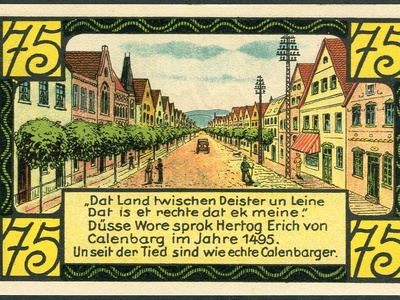
Eastphalian
Eastphalian blends Low German grammar with local sounds; less intelligible to southern Germans and important for regional identity in towns like Braunschweig.
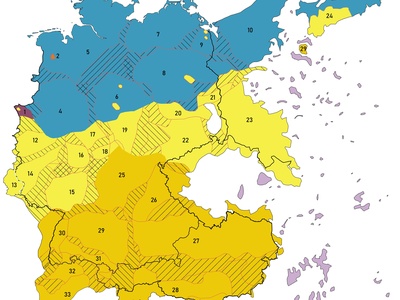
Mecklenburgisch-Vorpommersch
A coastal Low German variant with Slavic-influenced vocabulary and conservative phonology; recognizable to other Low German speakers but often opaque to Standard German listeners.
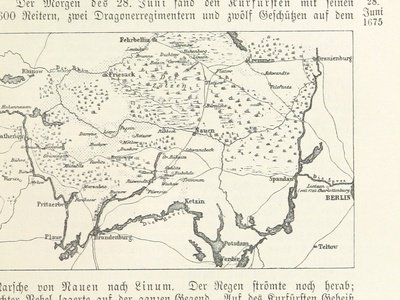
Brandenburgisch
A transitional dialect with Low German roots and Central German influences; features include vowel reductions and regional lexicon, partly intelligible to Standard German speakers.
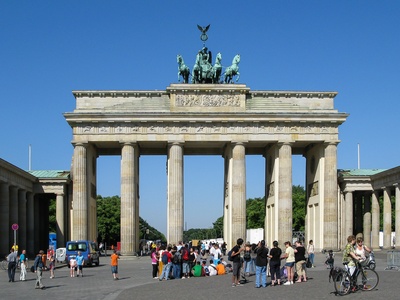
Berlinerisch
Urban Berlin speech mixing Brandenburgisch, Low German, and immigrant influences; notable for dropped consonants and unique slang, it’s a strong regional identity marker yet largely understandable to Standard German speakers.
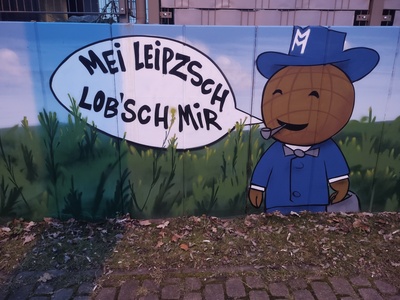
Sächsisch (Upper Saxon)
Distinctive for its vocalic shifts and “soft” consonants, Upper Saxon is often stereotyped and can be hard for non-natives to follow, though it remains clearly part of the German dialect continuum.
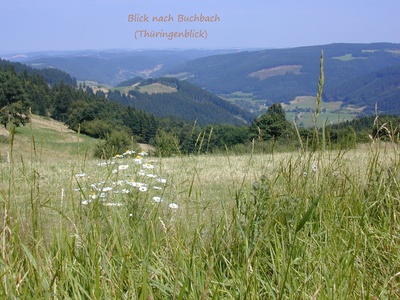
Thüringisch (Thuringian)
Thuringian has reduced vowels and consonant changes putting it between Upper Saxon and Hessian; locals maintain strong dialect features that may challenge outsiders’ comprehension.
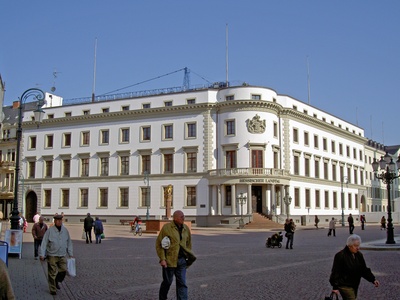
Hessisch (Hessian)
Hessian varieties are known for vowel shifts and clipped rhythm; urban forms are milder while rural speech preserves strong features, usually intelligible but regionally colored.
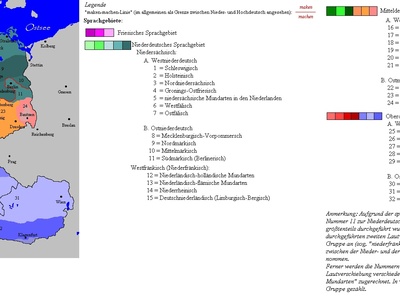
Ripuarian
Ripuarian includes Cologne and surrounding dialects with distinctive intonation and consonant patterns; some varieties, like Kölsch, are quite regional and less intelligible to distant Germans.

Kölsch
The Cologne city dialect is famous for melodic intonation, special words, and cultural visibility; it diverges noticeably from Standard German but remains understandable to many Germans with effort.
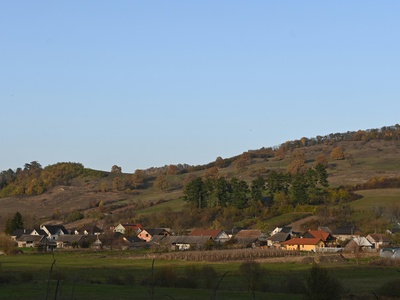
Moselfränkisch (Moselle Franconian)
Moselle Franconian features unique vowels and local vocabulary across small towns; it links to Luxembourgish dialects and can be challenging for Standard German-only speakers.
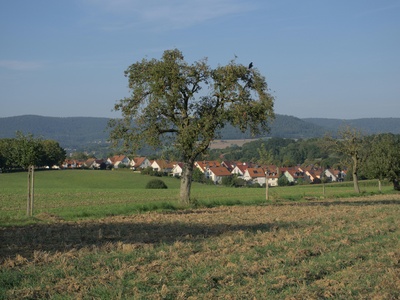
Pfälzisch (Palatine German)
Palatine German has strong vowel changes and rhythmic patterns; widely used in everyday speech in the region and partially intelligible to other Germans.
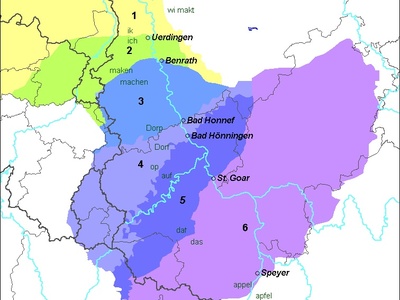
Saarländisch
Saarland dialect mixes Moselle Franconian with French loanwords and distinct pronunciation; familiar locally but can sound quite different to outsiders.
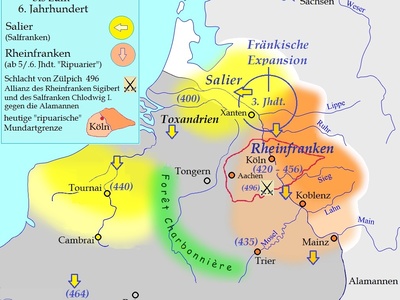
Rheinfränkisch (Rhenish Franconian)
Rheinfränkisch shows varied local forms along the Rhine with shared Franconian features; speakers often understand Standard German but maintain strong regional speech.
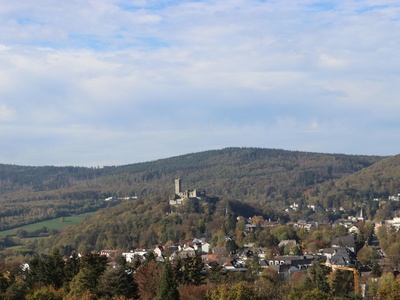
Rhenish (Rheinisch)
A broad regional grouping with expressive intonation and lexical traits; Rhenish dialects are culturally visible and range from mildly to strongly divergent from Standard German.
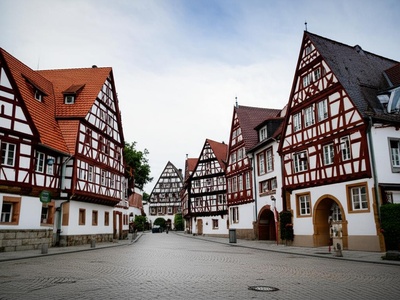
Mainfränkisch (Main Franconian)
Mainfränkisch blends Franconian traits with local pronunciations; intelligible within Franconian areas but distinctive compared to Standard German.
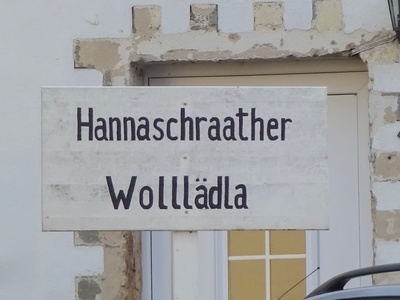
Oberfränkisch (Upper Franconian)
Upper Franconian dialects present consonant and vowel patterns unique to northern Bavaria, easily recognized locally though sometimes hard for outsiders.
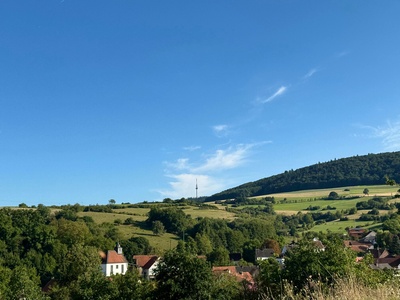
Unterfränkisch (Lower Franconian in Bavaria)
Lower Franconian varieties in Bavaria show mellow sounds and regional vocabulary, linking to broader Franconian speech but with local identity.
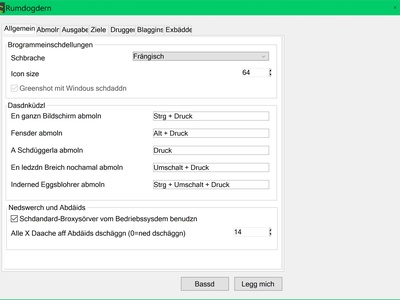
Fränkisch (East Franconian)
Franconian dialects bridge Upper and Central German with pitch and vowel differences; common throughout Franconia and variably intelligible to other Germans.
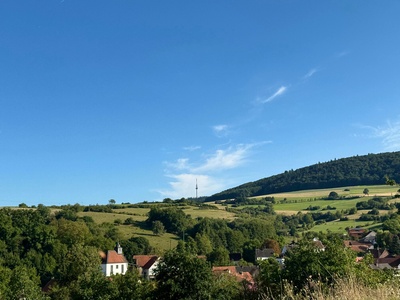
Bairisch (Bavarian)
Bavarian dialects have strong vowel shifts and distinct grammar; widely spoken across Bavaria, often hard for non-Bavarians to understand and central to regional identity.

Nordbairisch (Northern Bavarian)
Northern Bavarian keeps pronounced consonants and local vocabulary; somewhat more accessible to Standard German speakers than southern variants.
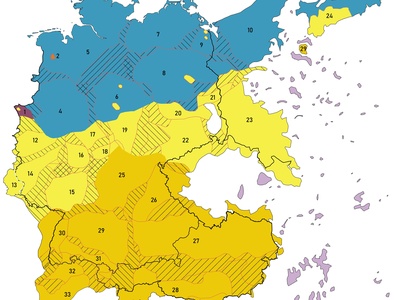
Mittelbairisch (Central Bavarian)
Central Bavarian is widespread around Munich and Salzburg (Austria), with melodic stress and frequent vowel changes, making it moderately distinct from Standard German.
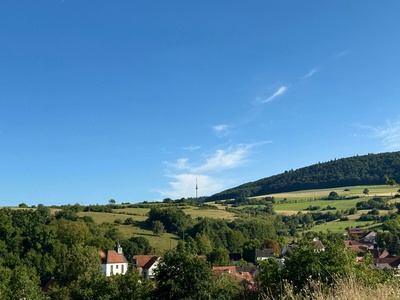
Südbairisch (Southern Bavarian)
Southern Bavarian is strongly dialectal with clipped consonants and archaic words; often least intelligible outside Alpine areas.
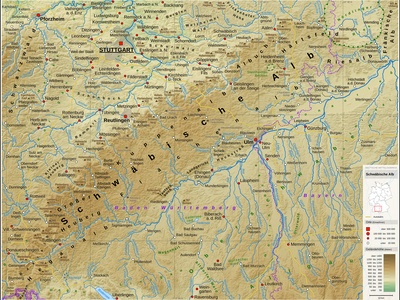
Schwäbisch (Swabian)
Swabian features vowel reductions and consonant shifts creating a recognizable accent; widely spoken in southwest Germany and sometimes hard for non-locals to follow.
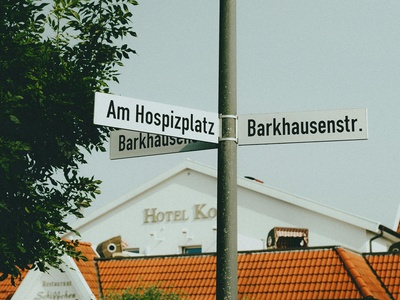
Badisch (Baden dialect)
Badisch covers a range from mild city speech to strong rural forms; its soft sounds and vocabulary link it to Alemannic speech and local identity.

Alemannisch (Alemannic, umbrella)
Alemannic covers Swabian and Badisch varieties with shared phonological traits; many forms are markedly different from Standard German and vary by valley and town.

Schwyz? (not in Germany) excluded
—

(NOTE: placeholder row removed)
—
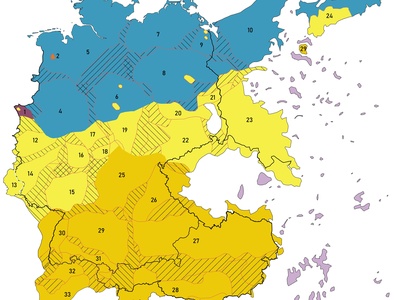
Niederrheinisch (Low Rhenish)
Low Rhenish has Dutch-influenced sounds and regional lexicon; it sits between Dutch and German dialect areas and can sound unfamiliar to Standard German speakers.
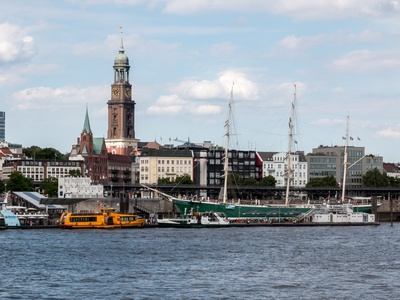
Hamburgisch
Hamburg dialect blends Low Saxon heritage with urban modern speech; city variants are lighter and generally comprehensible to Standard German speakers while retaining local words.
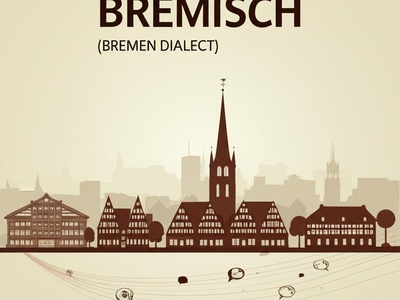
Bremisch (Bremen dialect)
Bremen’s speech mixes Platt influences with standard features; locally distinct but usually accessible to Standard German listeners.
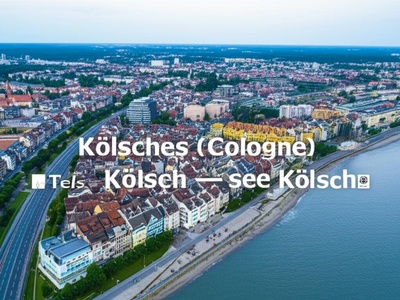
Kölsches (Cologne) — see Kölsch
See Kölsch entry for Cologne city dialect.

Palatine Yiddish? (excluded)
—
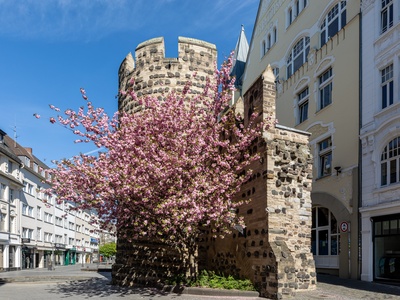
(Preserved to ensure no non-German languages are listed)
—
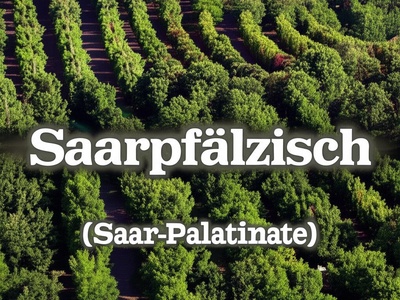
Saarpfälzisch (Saar-Palatinate)
Border dialect blending Palatine and Saarland features with occasional French loanwords; strongly regional and moderately intelligible to other German speakers.
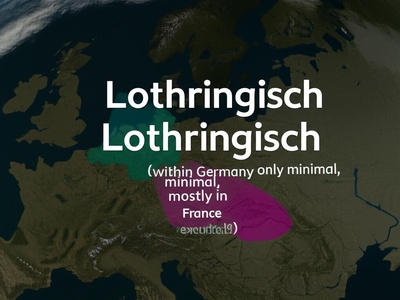
Lothringisch (within Germany only minimal, mostly in France excluded)
—
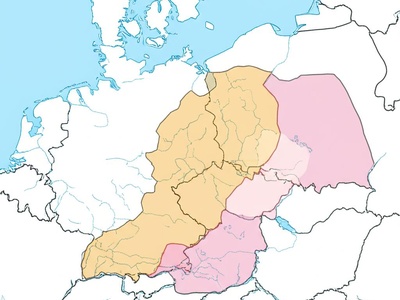
(Historical cross-border forms excluded when not substantially within modern Germany)
—
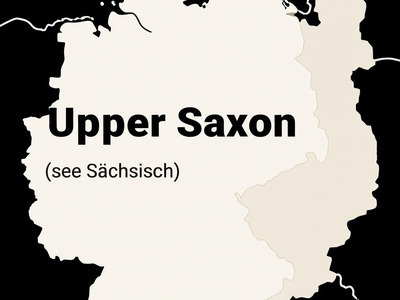
Upper Saxon (see Sächsisch)
See Sächsisch entry for Upper Saxon.
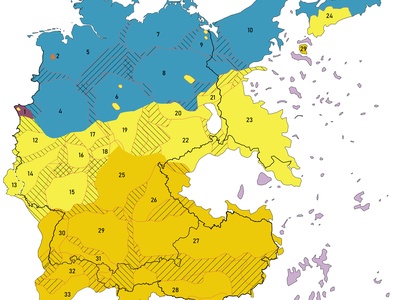
Thuringian-Upper Saxon
A continuum between Thuringian and Upper Saxon with blended features; local speech varies but remains part of the Central German dialect area and often distinct from Standard German.
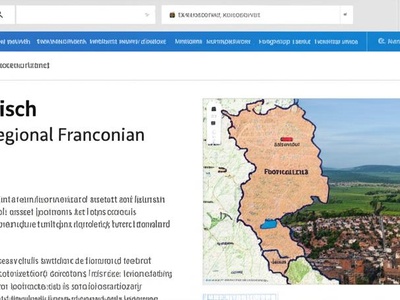
Hohenloherisch (widely cited regional Franconian dialect)
A named Franconian variety cited in linguistic literature; notable for local vowel patterns and consonant retention, intelligible regionally but distinct from Standard German.

Markbrandenburgisch (Brandenburg)
Historic Brandenburg speech showing rural Low German traits and Central German shifts; retains local words and pronunciation differences from Standard German.

Aachener Platt
Aachen’s dialect mixes Ripuarian rhythms with cross-border Low Franconian influences; culturally distinct and moderately intelligible to Standard German speakers.
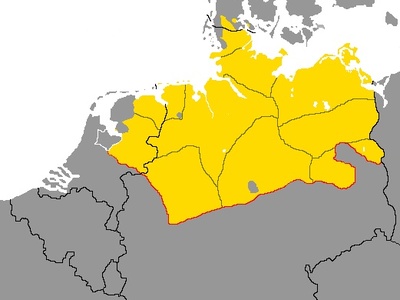
Ostfriesisch (East Frisian Low German)
Not to be confused with Frisian languages: East Frisian Low German is a Low German variant spoken in coastal rural areas with maritime vocabulary and conservative grammar, fairly distinct from Standard German.
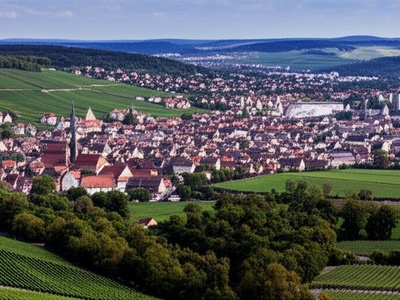
Palatine (see Pfälzisch)
See Pfälzisch entry for Palatine German.
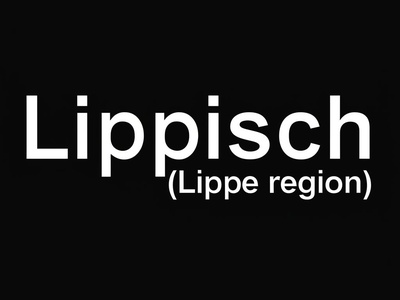
Lippisch (Lippe region)
Lippisch is a recognized regional variety with characteristic intonation and vocabulary within the Westphalian area; locally familiar but different from Standard German.
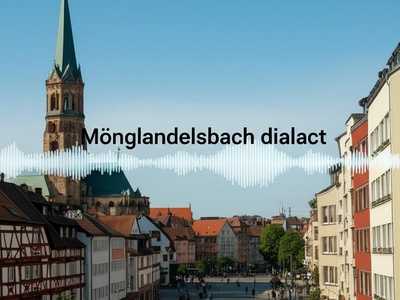
Mönchengladbach dialect (widely cited)
A regional city dialect often referenced in studies; mixes nearby Rhenish features with urban speech, preserving local lexicon and speech rhythms.
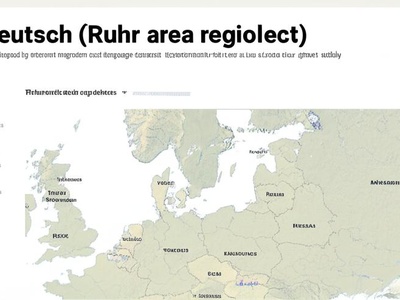
Ruhrdeutsch (Ruhr area regiolect)
An urban regiolect shaped by internal migration and language contact in Germany’s industrial Ruhr area; less a traditional dialect, more a distinct urban speech widely understood.
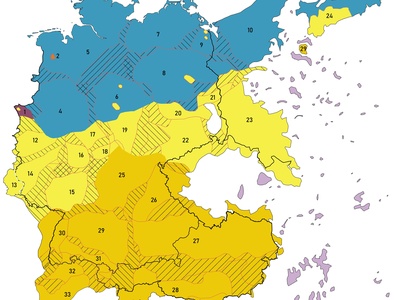
Sächsisch-Thüringisch (dialect continuum)
A transitional set of varieties between Saxon and Thuringian speech with shared phonetic traits; intelligibility varies but forms a recognized regional continuum.
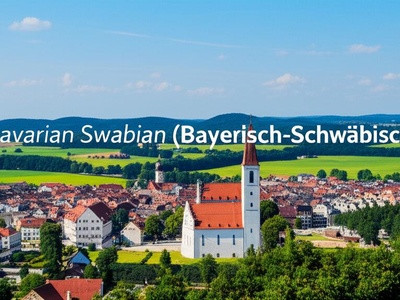
Bavarian Swabian (Bayerisch-Schwäbisch)
Local speech in Bavarian-administered Swabian areas mixing Swabian and Bavarian features; regionally identifiable and moderately distinct from Standard German.
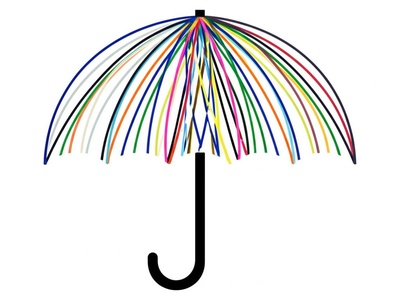
Franconian umbrella (Fränkisch)
An umbrella term for several Franconian dialects with shared historical traits; Franconian speech varies widely and is an important regional identity marker distinct from Standard German.
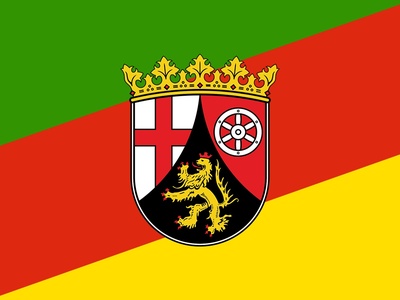
Hunsrückisch (Rhineland-Palatinate)
Hunsrück dialect features conservative sounds and local lexicon; known from regional literature and partly intelligible to nearby German dialect speakers.
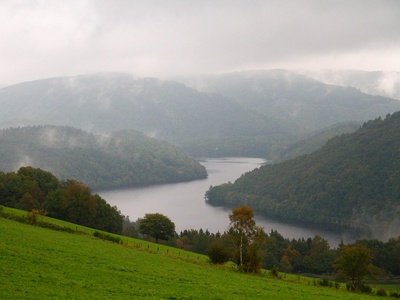
Eifeler (Eifel region)
Eifel dialects share Rhenish traits with rural features and distinct vocabulary; regionally strong and sometimes challenging for outsiders.

Unterelbe dialects (Elbe region)
River Elbe varieties retain older Low German forms and riverine vocabulary; intelligible within Low German areas but different from Standard German.

Kurpfälzisch (Electoral Palatinate region)
Kurpfälzisch is a well-documented Palatine variety with unique pronunciation and words, prominent in local culture and moderately intelligible to other Germans.

Lüneburg dialect (Lüneburg Heath)
A named northern Low Saxon variety cited in literature; retains rural Platt features and is regionally distinct though accessible to other Low German speakers.

